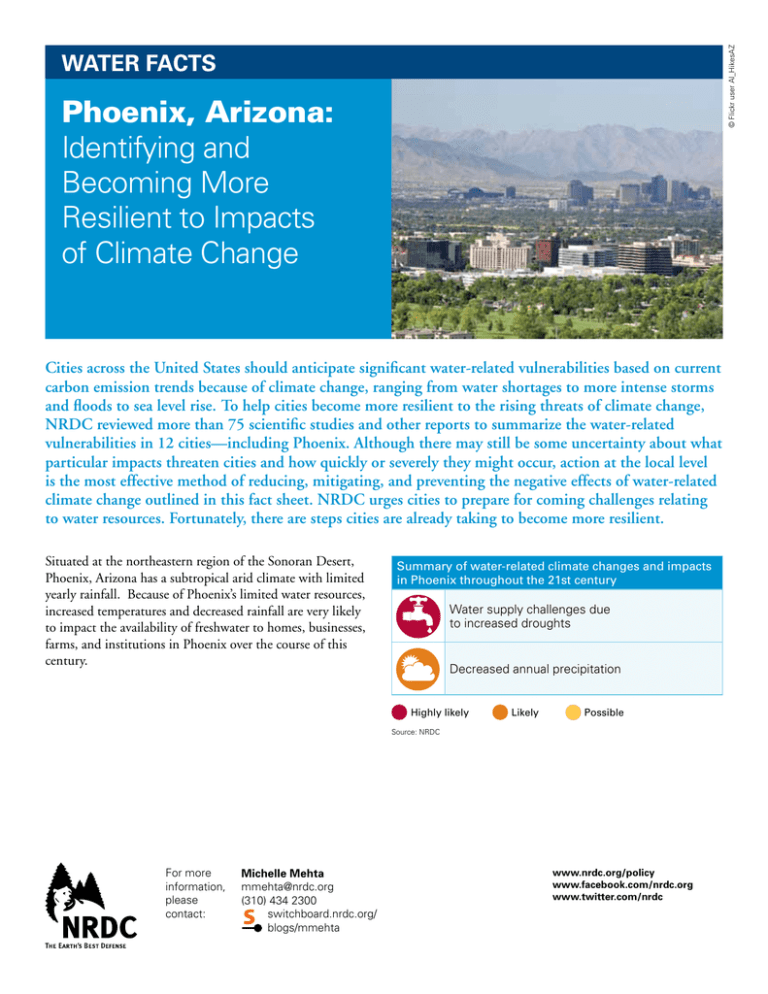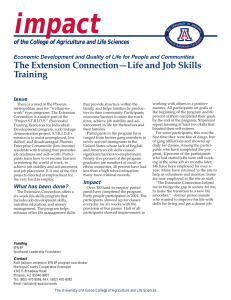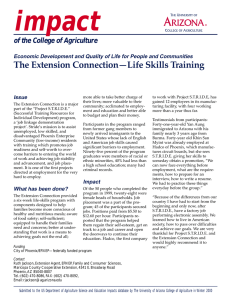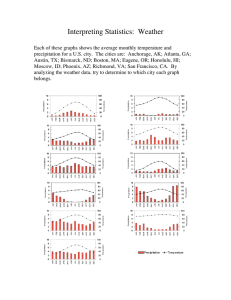NRDC: Phoenix, Arizona-Identifying and Becoming More Resilient
advertisement

© Flickr user Al_HikesAZ Water facts Phoenix, Arizona: Identifying and Becoming More Resilient to Impacts of Climate Change Cities across the United States should anticipate significant water-related vulnerabilities based on current carbon emission trends because of climate change, ranging from water shortages to more intense storms and floods to sea level rise. To help cities become more resilient to the rising threats of climate change, NRDC reviewed more than 75 scientific studies and other reports to summarize the water-related vulnerabilities in 12 cities—including Phoenix. Although there may still be some uncertainty about what particular impacts threaten cities and how quickly or severely they might occur, action at the local level is the most effective method of reducing, mitigating, and preventing the negative effects of water-related climate change outlined in this fact sheet. NRDC urges cities to prepare for coming challenges relating to water resources. Fortunately, there are steps cities are already taking to become more resilient. Situated at the northeastern region of the Sonoran Desert, Phoenix, Arizona has a subtropical arid climate with limited yearly rainfall. Because of Phoenix’s limited water resources, increased temperatures and decreased rainfall are very likely to impact the availability of freshwater to homes, businesses, farms, and institutions in Phoenix over the course of this century. Summary of water-related climate changes and impacts in Phoenix throughout the 21st century Water supply challenges due to increased droughts Decreased annual precipitation Highly likely Likely Possible Source: NRDC For more information, please contact: Michelle Mehta mmehta@nrdc.org (310) 434 2300 switchboard.nrdc.org/ blogs/mmehta www.nrdc.org/policy www.facebook.com/nrdc.org www.twitter.com/nrdc Precipitation and Droughts Precipitation is projected to decline in southern Arizona by 5 to 10 percent by 2100. Although summer monsoons can bring significant rainfall, high temperatures cause much of that moisture to immediately evaporate. Winter snowfalls, which are crucial to the management of the city’s water supply, may be decreasing. These factors indicate increased 360,000 drought for the region. 340,000 Water Demand (AF) Water Supply Challenges 320,000 Higher temperatures and decreased precipitation are expected to reduce water supplies. 300,000Based on the average of climate scenarios, runoff into the Salt and Verde watersheds—from 280,000 where Phoenix gets much of its water supply—could decrease 260,000 by 23 percent. Water imported from the Colorado River system through the240,000 Central Arizona Project (CAP) helps to alleviate the impact of droughts, but has been below 220,000 capacity due to drought conditions and over-allocation. During prolonged or severe drought conditions, the city may not be able to count on water from CAP. Reduced surface water supplies necessitate groundwater withdrawals to meet demand, but overuse of groundwater can cause land subsidence and reduced water quality. Another factor affecting future water availability in Phoenix is population growth. Expanding population could result in demand exceeding supply by 2030, and higher temperatures combined with drought conditions would increase annual household water use even further because of increased evapotranspiration. Action Phoenix’s efforts to adapt to climate change are centered on water resource management. Given its arid climate, the city had already developed strategies to address potential deficit conditions between water supply and demand before climate change became a dominant factor. For instance, through 1,600,000 water demand management, the city has been able to decrease per capita water consumption despite recent population 1,400,000 growth. Though current climate research has not yet yielded 1,200,000 data sufficient to be directly incorporated into the decision process, the city is planning for a variety of future water 1,000,000 supply shortage scenarios. For instance, Phoenix currently 800,000 stores excess surface water supplies in underground aquifers 600,000 through the Granite Reef Underground Storage Project; and it uses more than 90 percent of the400,000 water treated by the city’s three wastewater treatment facilities for crop irrigation, golf 200,000 course watering, habitat restoration, and industrial cooling. Population Increased Temperature Average temperatures are already on the rise in Phoenix. According to the Southwest Climate Change Network, “The Southwest is projected to warm faster than the world as a whole in the coming decades, with summer temperatures rising even faster than winter ones. Average annual temperatures in many parts of the region could be 5 to 8 degrees F [2.8 to 4.4 C] higher than they were even during the hot quarter-century that began in the 1970’s.” 200,000 9 19 8 99 20 00 20 01 20 02 20 03 20 04 20 05 20 06 20 0 20 7 08 20 09 20 10 97 96 95 94 93 92 91 90 0 19 19 19 19 19 19 19 19 19 City of Phoenix per-capita water consumption 280 Total GPCD (produced including system losses) Residential GPCD (metered deliveries) 260 240 GPCD 220 200 180 160 140 120 19 95 19 96 19 97 19 98 19 99 20 00 20 01 20 02 20 03 20 04 20 05 20 06 20 07 20 08 20 09 20 10 94 19 93 19 92 19 91 19 19 90 100 Source: Adapted from City of Phoenix Printed on recycled paper © Natural Resources Defense Council July 2011 www.nrdc.org/policy





